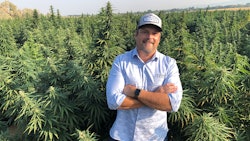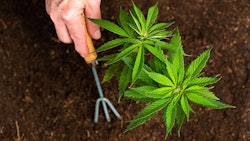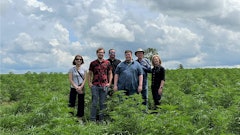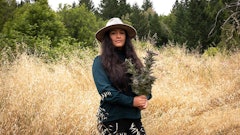
The 2018 Farm Bill opened research opportunities for hemp after years of prohibition, and now, researchers at Cornell University and North Carolina State University are taking full advantage.
The teams are wrapping up the second year of collaborating on a three-year hemp breeding study aimed at optimizing genetics for domestic farmers, who have been largely limited to growing hemp varieties bred in Canada and Europe that don’t always thrive in all regions of the U.S.
The Foundation for Food & Agriculture Research’s (FFAR) Hemp Research Consortium provided two grants totaling $1,170,000 to Cornell University last month to support the ongoing breeding program, which is meant to streamline hemp cultivation for grain, fiber and CBD in various U.S. regions. Consortium partners then contributed matching funds for a total investment of $2,340,000.
Cornell University’s research team, led by Dr. Larry Smart, professor at Cornell’s School of Integrative Plant Science Horticulture Section Plant Breeding and Genetics Section, is trying to understand the genetic basis of photoperiod threshold, or the amount of light a plant needs to flower and meet other developmental milestones.
“The company that is supporting us is a large grower in Florida, and what they have found is that the vast majority of CBD hemp cultivars, when they grow them at their latitude, they flower almost immediately,” Smart says. “There’s hardly any biomass yield, and it’s not economically viable to grow those cultivars at that low latitude.”
The new hemp cultivars produced from the breeding program are bred for specific traits using marker-assisted selection—that is, using markers such as DNA that are linked to desired plant traits to help choose plants for breeding—to improve the varieties’ performance in southern climates. Cornell researchers are selecting cultivars from plants grown in trials in New York, North Carolina and Florida.
The research team also plans to use whole genome sequencing to understand the genetic basis for flowering time variation, as well as develop molecule markers to optimize breeding of cultivars for southern areas. The selections will then be bred further to produce varieties with photoperiods that make them ideal cultivars for North Carolina, Florida and other similar locations.
“There’s also a basic research aspect of that project in that we are also hoping to map genes involved in flowering time,” Smart says. “We are also doing some whole genome sequencing of all of the plants that we grew last year, and then we’re hoping that we can then use the variation in flowering time that we saw last year. It was a huge variation in flowering time among, … in total, a little more than a thousand plants across all three sites. That should give us a powerful genetic mapping population to be able to identify the genes involved in flowering time.”
Smart’s team at Cornell University is collaborating with researchers at North Carolina State University, led by David Suchoff, the university’s alternative crops extension specialist and an assistant professor.
“[We] have been selecting the latest flowering lines that also produce a decent amount of biomass and a decent amount of CBD,” Smart says. “That’s the applied breeding goal, and we are finishing our second year of selection. Based on our first year of selection, we now have some varieties that are flowering significantly later than the original population. So, it looks like our selections are doing exactly what we are hoping that they would do.”
Suchoff says North Carolina State University’s hemp research was focused, in the early days, on floral/cannabinoid hemp because that was what the industry was most interested in when the 2018 Farm Bill first passed and legalized the production and sale of hemp in the U.S. Since that time, Suchoff says the focus—for both industry and researchers—has shifted to both cannabinoid and fiber hemp.
“We have really expanded the work we’re doing here at NC State pertaining to fiber hemp just because we’ve got a lot of farmers that are interested,” he says. “We’ve got a lot of really interesting, unique industries developing in North Carolina, in the Southeast, pertaining to fiber hemp, both processors and then end-use manufacturers. One of the big challenges we’ve had with hemp in general, especially fiber hemp, is that it is day-length sensitive. And most of the varieties that are available commercially are bred in more northerly latitudes.”
The teams have been working together to evaluate biomass production, analyze plant metrics like height and stem diameter, and, perhaps most importantly, Suchoff says, record when the crop starts to bloom. Researchers have been regularly visiting the fields to visually inspect the plants and record the date that each one starts to flower. The team also flew drones over all three cultivation sites and is working to develop algorithms from the drone images that will allow the researchers to identify when the plants begin to flower.
Smart says he hopes the team can also predict biomass yield from the drone images.
“That would all be very helpful in our breeding program if we don’t have to physically go out and chop down the plants and weigh them, if we can just fly a drone and calculate the biomass yield from the drone images,” he says.
Researchers are also assessing the fiber qualities to determine how the end product might be used in different applications and industries.
“We are also looking at cannabinoids, … more so to verify that it doesn’t produce THC,” Suchoff says. “Unfortunately, with a lot of the Chinese genetics, they still have not yet bred out THCA’s gene, so that means that you can have a crop that does go hot. What Larry’s been working on is developing these varieties that not only are a good fit for the Southeast, but also don’t produce any appreciable amount of THC so that farmers don’t have to worry about having a hot crop or even a negligent crop or negligent violation.”
The researchers are also working on producing a dual-purpose crop that can be used for both fiber and grain.
“We’re harvesting the flowers up at the top of the plant,” Suchoff says. “We’re also looking at how much of the stem is harvestable for fiber production, as well. So, [it’s] really a true dual-crop system where a farmer can get almost two crops out of one.”
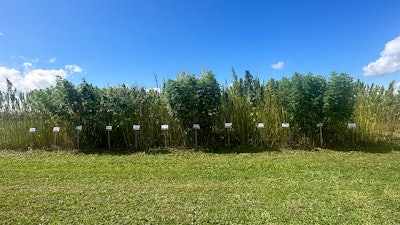
The results of the research will ultimately help researchers develop and commercially sell dual-purpose hemp varieties that are better suited for cultivation in certain regions of the U.S., particularly the Northeast and Southeast.
“Larry will eventually be able to release varieties that are a good fit and … industries can have the opportunity to license those seeds if they want to sell them,” Suchoff says. “Unfortunately, here at NC State, we don’t have a hemp breeder, so we haven’t had anyone that can kind of do what Larry is doing.”
International Hemp, a U.S.-based hemp seed company, is supporting Cornell University’s hemp breeding program, which has resulted in the development of two new cultivars to date.
The cultivars will have Ursa, the genus of a bear, in their name in a nod to Cornell’s mascot.
“Then, the two specific cultivars that we’re commercializing together with International Hemp are called Alta, that’s the fiber variety, and Grande, which will be a dual-purpose grain and fiber variety,” Smart says. “It has relatively large seeds—that’s why we called it Grande. So, we will be calling those Ursa Alta and Ursa Grande. And the grant project is to work on scaling up seed of those two cultivars so that they can be developed for certified seed and sold commercially, hopefully by 2025.”
Smart’s team is working with Suchoff’s researchers at North Carolina State University and Bob Pearce, a plant and soil sciences specialist at the University of Kentucky, to evaluate the yield and quality of Ursa Alta and Ursa Grande.
RELATED: Supporting Kentucky Hemp One Research Project at a Time
“We’re also working with Zach Brym at University of Florida and Calvin Trostle at Texas A&M University in Lubbock,” Smart says. “We are in the second year of evaluating the yield potential of those two new Cornell fiber and dual-purpose varieties across those multiple sites, and then as another task of the project, we are working on breeding other new cultivars that we think will produce high yields of grain and fiber.”
Smart’s team hopes to publish its research in a peer-reviewed publication next spring, which is also around the time the researchers hope to have some results on the mapping of flowering time with the CBD varieties grown in Florida.
“Both of these projects are related in that they are aimed at developing cultivars that will perform well at southern latitudes,” Smart says. “I know there are hemp fiber companies that are just starting their equipment, opening their plants [and] processing facilities in Texas. But to be honest, up until now, there have not been good fiber hemp cultivars that will grow well in Texas. We think that our two new cultivars are going to perform well at that latitude, and we’ll be able to support those companies that are on their way to developing a fiber industry at southern latitudes. And likewise, after some initial enthusiasm around CBD hemp at southern latitudes, I think a lot of growers sort of gave up on the crop because the cultivars were not yielding well enough. So, we are hopeful by the end of this project that we will have new cultivars that will be able to support a CBD industry at those southern latitudes in Florida.”
Smart points to the research as an example of an industry/university partnership that is funded by federal dollars, and he hopes continued funding of FFAR is included in the new Farm Bill.
RELATED: 2023 Farm Bill Passage Could Face 1-Year Delay, According to Key US Senator
It can be challenging to secure funding for hemp research, Suchoff says, and researchers often apply for U.S. Department of Agriculture (USDA) grants and other hemp-specific programs to avoid competing with corn and soybean farmers, for example.
“Often when we’re applying to a grant, it may be to a larger program, meaning we’re going to have to compete with researchers who are working on corn and soybeans and cotton or other traditional commodity crops,” Suchoff says. “And when you think about the proposal that you’re developing and the story you're trying to tell, even though there’s certainly a lot of excitement around hemp, a lot of times folks that are, say, working with corn, can leverage the fact that they’ve got millions of acres in production and talk about the impact that they’ll have immediately.”
The universities’ work is still important, of course, as it will help provide greater genetic variety for hemp farmers to choose from, as well as help develop cultivars that perform better in specific regions of the country.
“We’ll have more domestic production of hemp, which in the long term, … will help reduce the cost of seed,” Suchoff says. “Right now, the cost of seed is one of the biggest input costs for farmers. That in turn increases the cost of production and the cost of that end product. It’s no surprise because we’re importing seed from China, and when you’re having to ship seed across the globe, it’s going to add a lot of cost to that seed. So, having genetics that are bred here and also then produced here domestically means that we can really start to reduce the overall cost of production. …
“We’re really excited to see more domestically available seed and having a lot more options for farmers is really going to help as this industry continues to evolve.”









